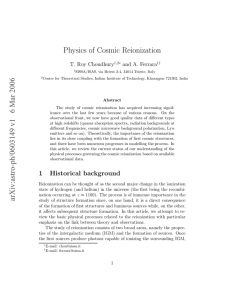Notre Dame Physics colloquium March 2010
advertisement
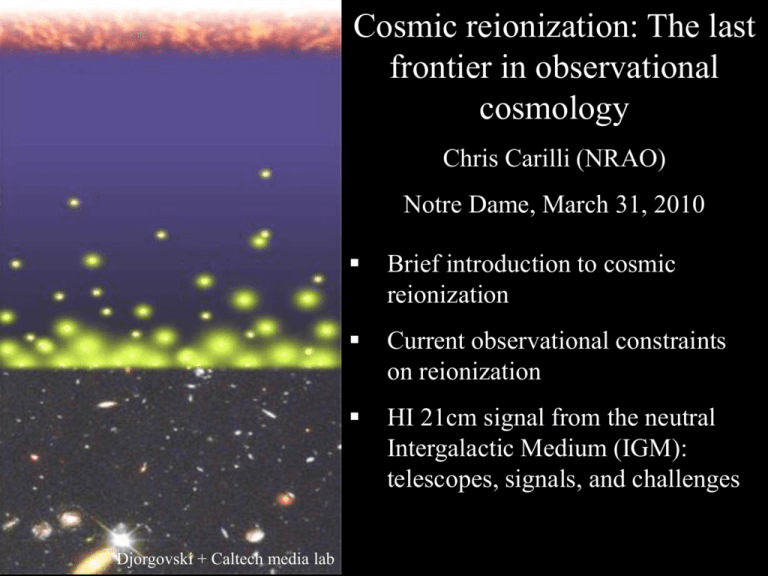
Cosmic reionization: The last frontier in observational cosmology Chris Carilli (NRAO) Notre Dame, March 31, 2010 Djorgovski + Caltech media lab Brief introduction to cosmic reionization Current observational constraints on reionization HI 21cm signal from the neutral Intergalactic Medium (IGM): telescopes, signals, and challenges References • Fan, Carilli, Keating 2006, ‘Observational constrains on cosmic reionization,’ ARAA, 44, 415 • Furlanetto et al. 2006, ‘Cosmology at low frequencies: The 21 cm transition and the high-redshift Universe’ Phys. Reports, 433, 181 • Ellis 2006, ‘First Light in the Universe,’ Saas-Fee Advanced Courses, Volume 36 Big Bang f(HI) ~ 0 Recombination History of Baryons (mostly hydrogen) 0.4 Myr z = 1000 Cosmic time (Cosmic expansion) Redshift 0.8 Gyr z ~ 7 to 15 13.6Gyr z=0 f(HI) ~ 1 Reionization f(HI) ~ 10-5 Recombination Early structure formation Cosmic microwave background Chris Carilli (NRAO) radiation Berlin June 29, 2005 WMAP – imprint of primordial structure from the Big Bang Hubble Space Telescope Late structure formation Realm of the Galaxies Dark Ages Cosmic Reionization • Last phase of cosmic evolution to be tested and explored • Reionization: ‘last cosmic phase transition’, setting a bench-mark in cosmic structure formation indicating the first luminous structures • Today’s focus: Evolution of the neutral intergalactic medium = ‘richest of all cosmological data sets’ Numerical Simulations of the evolution of the Intergalactic Medium (IGM) through reionization Three phases •Dark Ages •Isolated bubbles (slow) •Percolation (overlapping bubbles fast) 10Mpc z=20 to 6; scale ~ superclusters of galaxies Gnedin 2006 Constraint I: Gunn-Peterson Effect (Gunn + Peterson 1963) neutral ionized quasar z=6.4 z SDSS high z quasars Lya absorption by neutral IGM Barkana and Loeb 2001 IGM after reionization ‘cosmic web’ = Ly alpha forest at z=3.6 ( < 10) Womble 96 • N(HI) = 1013 to 1015 cm-2 • neutral fraction: f(HI) = 10-5 to 10-6 6.4 Constraint I: GunnPeterson absorption SDSS z~6 quasars => pushing into reionization? GP = 2.6e4 f(HI) (1+z)3/2 z=6.4 5.7 GunnPeterson limits to f(HI) marked increase in neutral fraction at z~ 6 f(HI) ~ 6e-5 at z = 5 f(HI) > 5e-4 at z = 6 But… • GP >>1 for f(HI)>0.001 => low f( ) diagnostic • τGP to f(HI) conversion requires ‘clumping factor’ z=1000 Constraint II: Large scale polarization of the CMB • Temperature fluctuations = density inhomogeneities at the surface of last scattering • e- scattering CMB during reionization => polarized • Large scale: horizon scale at reionization ~ 10 deg Hinshaw et al. 2008 Constraint II: CMB large scale polarization WMAP Angular power spectrum = variance as function of angular scale (square of visibility function) Polarized signal is weak: uK rms ~ 1% total intensity on scales l < 10 or angles > 20o e = 0.087 +/- 0.015 ~ d/mfp ~ d ne e f(HI) (1+z)2 Baryon Acoustic Oscillations: Sound horizon at recombination Jarosik et al 2010 Constraint II: CMB large scale polarization Rules-out high ionization fraction at z > 15 Allows for small (≤ 0.2) ionization to high z Most action occurs at z ~ 7 to 15 Dunkley et al. 2008 Combined CMB + GP constraints on reionization Finite ionization fraction persists to z~10 But… • e = integral measure to recombination=> allows many IGM histories • How to connect the dots? z=6.42 Quasar Near Zones • Accurate host galaxy redshift from eg. CO: z=6.419 • Quasar near zone: photons leaking down to z=6.32 White et al. 2003 z=6.32 ionized ‘time bounded’ Stromgren sphere RNZ = 4.7Mpc [f(HI) Nγ tQ]1/3(1+z)-1 Quasar Near-Zones: 25 GP quasars at z=5.7 to 6.5 R Nγ1/3 LUV LUV • Correlation of RNZ with UV luminosity • No correlation of UV luminosity with redshift Quasar Near-Zones <RNZ> = 9.8Mpc 4.2Mpc RNZ = 7.4 – 8.0(z-6) •RNZ decreases by factor 2.3 •f(HI) increases by factor 9 from z=5.7 to 6.5 * Rule-out rapid early or late reionization * Not ‘event’ but complex process, large variance: zreion ~ 6 to 15 * Good evidence for qualitative change in nature of IGM at z~6 integral measure? Local ioniz.? Local ionization? Clumping? saturates Amazing progress, but current probes are all limited diagnostics Need more direct probe of process of reionization ESO HI 21cm line: Most direct probe of the neutral IGM during cosmic reionization, and the preceding ‘dark ages’ • Spin-spin coupling: magnetic hyperfine transition • Low frequencies: νobs = 1420MHz/(1+z) ≤ 200 MHz Advantages of the 21cm line • Spectral line signal => full three dimensional diagnostic of structure formation. • Direct probe of IGM = dominant component of baryons during reinization/dark ages • Hyperfine transition = forbidden (weak) => avoid saturation MWA (MIT/CfA/ANU) 21CMA (China): 10,000 Dipole array working in Western China 2008 32 Tile array deployment in WA 2009 Pathfinders: 1% to 10% of a square kilometer array Site Type Freq MHz Area m2 Goal Date GMRT India Parabola 150-165 4e4 CSS 2009 21CMA China Dipole 70-200 1e5 PS 2008 PAPER GB/Oz/SA Dipole 110-200 5e3 PS/CSS 2009 MWAdemo Oz Aperture 80-300 1e4 PS/CSS 2009 LOFAR NL Aperture 115-240 1e5 PS/CSS 2010 SKA ?? Aperture 30-300 1e6 Imaging ?? HI 21cm emission from neutral IGM: large scale structure, not individual galaxies TCMB 1 z 1/ 2 0.008( )( ) f HI (1 ) TS 10 1e13 Mo Large scale structure cosmic density, neutral fraction, f(HI) Temp: TK, TCMB, Tspin 1e9 Mo ~ Milky Way Signal I: Global (all sky) emission (eg. TCMB) Signal ~ 20mK Feedback ‘slows-down’ galaxy formation No Feedback Interplay of ρ, T, f(HI) Resonant scattering of Lya from first galaxies (FieldWouthuysen effect) couples TS to TK which is < TCMB Furlanetto, Oh, Briggs 06 Signal II: HI 21cm Tomography of IGM 9 z=12 TB(2’) ~ 20 mK SKA rms ~4mK Pathfinders: rms ~ 80mK 7.6 Furlanetto, Zaldarriaga + 2004 Signal III: 3D Power spectrum major advantage over CMB characteristic bubble scale z=10.5, f(HI) = 0.9 z=6.5, f(HI) = 0.02 Barkana 2009 Signal III: 3D Power spectrum within reach of pathfinders Pathfinders at z=8 (158MHz) Bowman et al. Signal IV: 21cm absorption toward first radio galaxies 19mJy z=12 z=8 SKA+Gnedin simul 130MHz 159MHz • radio GP (=1%) • Only probe of small scale structure • 21 Forest (10%) • Requires radio sources: expect 0.05 to 0.5 deg-2 at z> 6 with S151 > 6 mJy Signal V: Cosmic Stromgren spheres around z > 6 QSOs Size ~ 15’ Signal ~ 20 x f(HI) mK 5Mpc = 0.5 x f(HI) mJy Wyithe et al. 2006 •Lya spectra provide evidence for existence for CSS • 21cm signal is within reach of pathfinder arrays 0.5 mJy •3D structure = powerful diagnostic Challenge I: Low frequency foreground – hot, confused sky Haslam, Eberg 408MHz • Coldest regions: T ~ 100 (/200 MHz)-2.6 K = 105 x 21cm signal • Highly ‘confused’: 1 source/deg2 with S140 > 1 Jy Solution: spectral decomposition (eg. Morales, Gnedin…) Foreground = non-thermal = featureless over ~ 100’s MHz Signal = fine scale structure on scales ~ few MHz Cygnus A Signal/Sky ~ 2e-5 10’ FoV; SKA 1000hrs 500MHz 5000MHz Requires gain calibration to ~ 0.1% accuracy Challenge II: Ionospheric phase errors – varying e- content ‘Isoplanatic patch’ = few deg = few km Speed of light in ionosphere is dependent function of ne Phase (path length) variation proportional to wavelength2 Challenge II: Ionospheric ‘seeing’ TIDs – ‘fuzz-out’ sources Solution: spatial/temporal calibration = Wide field ‘rubber screen’ phase selfcalibration using data-rich sky 15’ Virgo A VLA 74 MHz Lane + 02 Challenge III: Interference 100 MHz z=13 200 MHz z=6 Solutions -- RFI Mitigation (Ellingson06) Aircraft Digital filtering Orbcomm TV Beam nulling Real-time ‘reference beam’ LOCATION! Beam nulling -- ASTRON/Dwingeloo (van Ardenne) Factor 300 reduction in power VLA-VHF: 180 – 200 MHz Prime focus X-dipole Greenhill, Blundell (SAO); Carilli, Perley (NRAO) Leverage: existing telescopes, IF, correlator, operations $110K design and construction First light: Feb 16, 05 Four element interferometry: May 05 Goal: first CSS detection Winter 06/07 Project abandoned: Digital TV KNMD Ch 9 150W at 100km Expected line RFI mitigation: location, location location… 100 people km^-2 ~VLA 1 km^-2 0.01 km^-2 Chippendale & Beresford 2007 PAPER: Precisions Array to Probe the Epoch of Reionization PIs Backer (UCB), Bradley (NRAO) see Parsons et al. 2010 • Optimize for reionization PS/CSS • FoV ~ 40deg, baselines ≤ 0.6km • Engineering array in RQ zone, Greenbank 16 stations • Science array in Karoo, South Africa 64 stations PAPER: Staged Engineering • Broad band sleeve dipole + flaps • FPGA-based correlator from Berkeley wireless lab • systematically tackle foregrounds, ionosphere, interference 100MHz Beam response BEE2: 5 FPGAs, 500 Gops/s 200MHz Interference PAPER South Africa FM OrbComm 100MHz OrbComm 200MHz 100MHz 200MHz PAPER SA Southern Sky 150MHz Detecting sources down to 1Jy (~2000x CSS signal) 105 signal Probing the Dark Ages using a Lunar low frequency array No interference No ionosphere Only place to study dark ages (< 60 MHz) RAE2 1973 10MHz Recognized as top astronomy priority for NASA Lunar exploration program (Livio ‘07) J. Burns, PI Colorado •Design specs for a ‘dark ages’ low frequency array on Moon •Relies on future heavy lift capabilities of Ares V (65 tons to moon) http://lunar.colorado.edu/ Cosmic reionization: the last frontier in observational cosmology • First constraints: GP absorption + CMB large scale polarization => reionization is a complex process over z ~ 15 to 6 Dark Ages (> 0.4Myr) • HI 21cm line is the most direct probe of reionization and the dark ages • Low freq pathfinders: promise of first detection of HI 21cm signal from reionization • SKA: ‘tomography’ of the evolution of the neutral IGM • LUNAR: probing the dark ages from the dark side of the moon Reionization (~ 1Gyr) END ESO Sources responsible for reionization Galaxies at z>7 <1um >1um HST/WFC3 Bouwens et al. 2010 Note: quasars (SMBH) are insufficient to cause reionization Reionization by normal galaxies Roberston + Ellis 2010 • z ~ 7 requires fesc > 0.2 and C < 30 • z ~ 8 requires fesc > 0.2 and C < 10 Spin Temperature n1 h 21 / kTs 3e n2 1. Collisions w. e- and atoms 2. Ambient photons (predominantly CMB) 3. Ly resonant scattering: Wouthuysen-Field effect = mixing of 1S HF levels through resonant scattering of Ly drives Ts to Tkin Ly 21cm h21/k = 0.067K Each Ly photon scatters ~ 1e5 times in IGM before redshifting out of freq window. HI 21cm radiative transfer: large scale structure of the IGM LSS: Neutral fraction / Cosmic density / Temperature: Spin, CMB Furlanetto et al. 2006 Dark Ages HI 21cm signal •z > 200: T = TK = Ts due to collisions + Thomson scattering => No signal •z ~ 30 to 200: TK decouples from T, but collisions keep Ts ~ TK => absorption signal T = 2.73(1+z) TK = 0.026(1+z)2 •z ~ 20 to 30: Density drops Ts~ T => No signal Furlanetto et al. 2006 TK T Enlightenment and Cosmic Reionization -- first luminous sources •z ~ 15 to 20: TS couples to TK via Lya scattering, but TK < T => absorption •z ~ 6 to 15: IGM is heated (Xrays, Lya, shocks), partially ionized => emission •z < 6: IGM is fully ionized Dark age HI 21cm signal: baryon oscillations 0.1 1.0 10 Mpc-1 Barkana & Loeb: “Richest of all cosmological data sets” • Three dimensional in linear regime • Probe to k ~ 103 Mpc-1 vs. CMB limit set by photon diffusion ~ 0.2Mpc-1 •Alcock-Pascinsky effect •Kaiser effect + peculiar velocites Challenge: sensitivity at very low frequency At l=3000, k=0.3 Mpc-1 PS detection • 1 SKA, 1 yr, 30MHz (z=50), 0.1MHz •TBsky = 100(/200MHz)-2.7 K = 1.7e4 K • Signal ~ 2 mK • Noise PS ~ 1 mK Requires few SKAs Chromatic aberration: Frequency differencing with MHz channels doesn’t work well due to frequency dependent far-out sidelobes 142, 174 MHz Datta + Dynamic range requirements on calibration errors • Daily cal errors < 0.2% • Monthly cal errors < 0.01% Constraint II: Large scale polarization of the CMB Thompson Scattering of the CMB during reionization WMAP HINSHAW et al. 2008 Scattering CMB local quadrapole => polarized Large scale: horizon scale at reionization ~ 10’s deg Constraint II: Large scale polarization of the CMB •Temperature fluctuations = density inhomogeneities at the surface of last scattering • Scattering CMB during reionization => polarized • Large scale: horizon scale at reionization ~ 10 deg z=1000
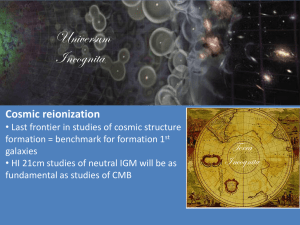
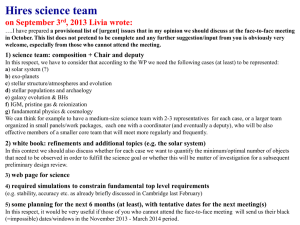
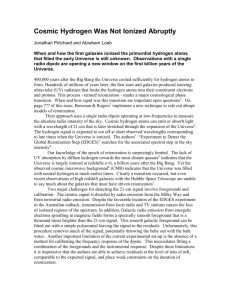
![Probing the epoch of reionization with tomographic [CII]](http://s2.studylib.net/store/data/005768347_1-7cace4bfe5576e1a87cbf90f5e08d4c8-300x300.png)
